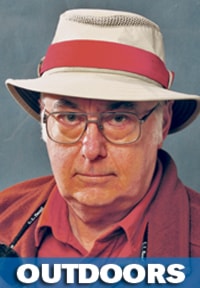The cover of the 2015 Alberta Guide to Sportfishing Regulations brought an agonized, involuntary groan from deep within me: a gorgeous portrait of a native fish — an Arctic grayling — a too-frequent sign in recent years of another native species in such trouble that yet another zero limit is being imposed on anglers.
Inside, the “Message from the Minister” confirms the worst, that the provincial Fish Sustainability Index shows “overall declines in Arctic grayling populations,” therefore “we are implementing a province wide catch —and — release regulation to better protect this species.”
Sixty years ago, more and less, Rocky Mountain whitefish were erroneously called “grayling” in Southern Alberta, just as walleye were misnamed “pickerel.”
As an uppity kid who knew the truth, I corrected adults about our walleye catches, and particularly yearned to quest for the holy grayling, the real thing, the Arctic grayling.
Forty-five or so years ago, the late Bob Tanghe of Edson, farmer-conservationist bighorn hunter, took pity and invited me and our mutual friend, Carl Hunt, the Alberta fisheries biologist stationed in Edson, to go Arctic grayling fishing with him in September.
It poured that summer and Carl and I noticed swathed grain steaming after the three days of hot sunshine as we drove into the Tanghe farm.
We suggested Bob should probably not go fishing, even offered to help turn the swathes.
“No thanks,” Bob Tanghe said, then uttered pure wisdom: “there’s always work; who knows how long we’ll be able to go fishing?”
So we slewed and slid a maze of resource roads all spilling impure mud and other crud into every watercourse, then hiked other grids of cut lines, finally arriving on the bank of a cold and grey Berland River.
Fishing was slow, but I did catch my first two or three gorgeous Arctic grayling and as many of Alberta’s only native rainbow trout, the Athabasca rainbow, fully mature fish at about 25 cm, still with the characteristic parr marks along their sides.
In his message, the minister tells us “we are progressing with plans to stock new trout species such as the Athabasca rainbow trout.”
Why bother? Where are you going to put them?
It is one of our oldest fish species, and we have allowed the forestry and energy industries to destroy its natural habitat with too many badly designed roads always with hanging culverts that stop spawning runs.
Here’s what the 2015 Barry Mitchell’s Fishing Guide has to say about the Berland River today: “It took 20-plus years of management to get populations to rebound to where they are today. … This is a sensitive watershed and land use and road density is pushing grayling populations.”
In his message, Minister Kyle Fawcett lauds the updated Fish Conservation and Management Strategy for Alberta, but increasingly angry anglers are saying we don’t need officials dinking away on computers in Edmonton; what we need are more biologists in the field trying to prevent the known damage being done to our fish habitats.
Hidden Creek, in the south, for example, spawning stream for 70 per cent of the bull trout in the Oldman watershed, is being destroyed by Mickey Mouse logging’s ruinous practices of cutting too close and on too steep slopes.
The Little Smoky River, North America’s first catch and release Arctic grayling fishery, is likewise being destroyed, plus thousands of cubic yards of water withdrawn for fracking.
The only real good news in this year’s Guide may have come by accident out of the Red Deer River oil spill in 2012: the whole watershed has been catch and release since, while “they” determined, finally, that the fish were safe to eat.
So the old rules are back, except that the formerly ruinous rule allowing of the killing of two brown trout per day after June 16 on the North and South Raven Rivers, provided they were more than 40-cm long is gone; whether accidentally, like mandatory barbless a couple of years ago, or wisely on purpose, we’ll never know.
We still have the harmful zero limits on Prairie Creek, and on walleye below the Dickson Dam down to Tolman Bridge, and the ridiculously low non-resident Canadian licence fee and free fishing for resident anglers over 65.
As I hunted for this year’s guide, licence vendors and government employees were telling me that the magazine is on borrowed time and will become a thing of the past.
Rob Miskosky, Guide publisher, points out that they don’t cost the government a penny to produce, but that at least one government official doesn’t like the advertising content that pays for the publication.
“But not everybody wants to go online or use their phone to access the regulations,” Miskosky says, “me included; it will cause an uproar if the hard-copy regs aren’t produced.”
Bob Tanghe wasn’t just thinking of death, illness and old age as reasons why we may not always be able to go fishing.
The former minister outlawed commercial fishing because it is unsustainable.
If we don’t make big changes in the way we treat fish habitats, how long will we be able to keep going before sport fishing becomes unsustainable because all the fish are either “at risk,” “threatened,” or “endangered?”
Bob Scammell is an award-winning columnist who lives in Red Deer. He can be reached at bscam@telusplanet.net.
